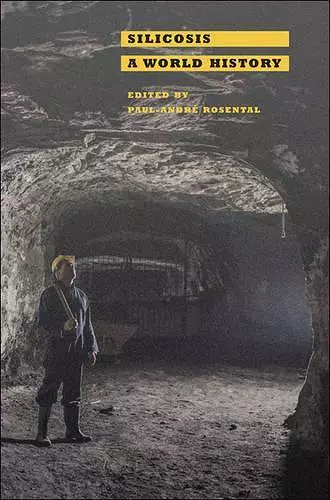Silicosis
A World History
Format:Hardback
Publisher:Johns Hopkins University Press
Published:30th May '17
Currently unavailable, and unfortunately no date known when it will be back

Bringing together a cross-disciplinary, international group of scholars to address the topic of silica-caused lung disease from a varied set of perspectives, Silicosis cogently and convincingly argues that the International Silicosis Conference of 1930 played a pivotal role in the history of this disease. -- Paul Blanc, MSPH, MD, University of California School of Medicine San Francisco
Despite the common perception that "black lung" has been relegated to the dustbin of history, silicosis remains a crucial public health problem that threatens millions of people around the world. This painful and incurable chronic disease, still present in old industrial regions, is now expanding rapidly in emerging economies around the globe. Most industrial sectors-including the metallurgical, glassworking, foundry, stonecutting, building, and tunneling industries-expose their workers to lethal crystalline silica dust. Dental prosthodontists are also at risk, as are sandblasters, pencil factory workers in developing nations, and anyone who handles concentrated sand squirt to clean oil tanks, build ships, or fade blue jeans. In Silicosis, eleven experts argue that silicosis is more than one of the most pressing global health concerns today-it is an epidemic in the making. Essays explain how the understanding of the disease has been shaken by new medical findings and technologies, developments in industrializing countries, and the spread of the disease to a wide range of professions beyond coal mining. Examining the global reactions to silicosis, the authors trace the history of the disease and show how this occupational health hazard first came to be recognized as well as the steps that were necessary to deal with it at that time. Adopting a global perspective, Silicosis offers comparative insights into a variety of different medical and political strategies to combat silicosis. It also analyzes the importance of transnational processes-carried on by international organizations and NGOs and sparked by waves of migrant labor-which have been central to the history of silicosis since the early twentieth century. Ultimately, by bringing together historians and physicians from around the world, Silicosis pioneers a new collective method of writing the global history of disease. Aimed at legal and public health scholars, physicians, political economists, social scientists, historians, and all readers concerned by labor and civil society movements in the contemporary world, this book contains lessons that will be applicable not only to people working on combating silicosis but also to people examining other occupational diseases now and in the future. Contributors: Alberto Baldasseroni, Francesco Carnevale, Eric Geerkens, Martin Lengwiler, Gerald Markowitz, Jock McCulloch, Joseph Melling, Julia Moses, Paul-Andre Rosental, David Rosner, Bernard Thomann
Although the reader may think this could be a heavy read, the book is set out well and it was easy to read. The author enables the reader to understand. It is referenced well. Some books of this genre can be difficult to read, as politics, legal and medical terminology can feel beyond the reader- this was not the case.
—Nursing Times
The authors make a powerful case that history matters to any analysis of the persistence of this iconic disease of industrialization... This well-researched and insightful transnational analysis of silicosis opens up new directions for historians of silicosis and other occupational diseases. As the contributors to this volume so poignantly confirm, accountability for diseases that ravage workers worldwide has yet to be adequately addressed.
—Lundy Braun, Brown University, Bulletin of the History of Medicine
This book embodies a fascinatingly diverse set of chapters that have been successfully integrated into a refreshing narrative of not only health and medical aspects of silicosis, but also important social, economic and public health aspects of this ultimately preventable condition. Respirable crystalline silica exposure at work remains common globally, and those interested in tackling the resulting current, and future, health risks would find significant interest and enjoyment in this book.
—David Fishwick, Occupational Medicine
Paul-André Rosental's edited collection Silicosis: A World History provides a full and nuanced understanding of the emergence of the concept of silicosis as an occupational disease . . . This is a comprehensive story of silicosis, dating back to the 1800s. It provides health practitioners, social historians, and scholars with a fascinating account of the discovery of the disease, the attempts of the mining companies to control and manage it (and, in some cases, hide it), and the people who cared enough to dedicate their lives to finding strategies for prevention and treatment . . . The authors have successfully imparted the history of silicosis beyond a narrow medical perspective, by acknowledging the strong influence of social forces on disease. In doing so, they have developed a framework for understanding responses to a range of other exposures such as asbestos and tobacco smoke.
—Jill Murray, University of the Witwatersrand, American Historical Review
ISBN: 9781421421551
Dimensions: 229mm x 152mm x 25mm
Weight: 522g
296 pages